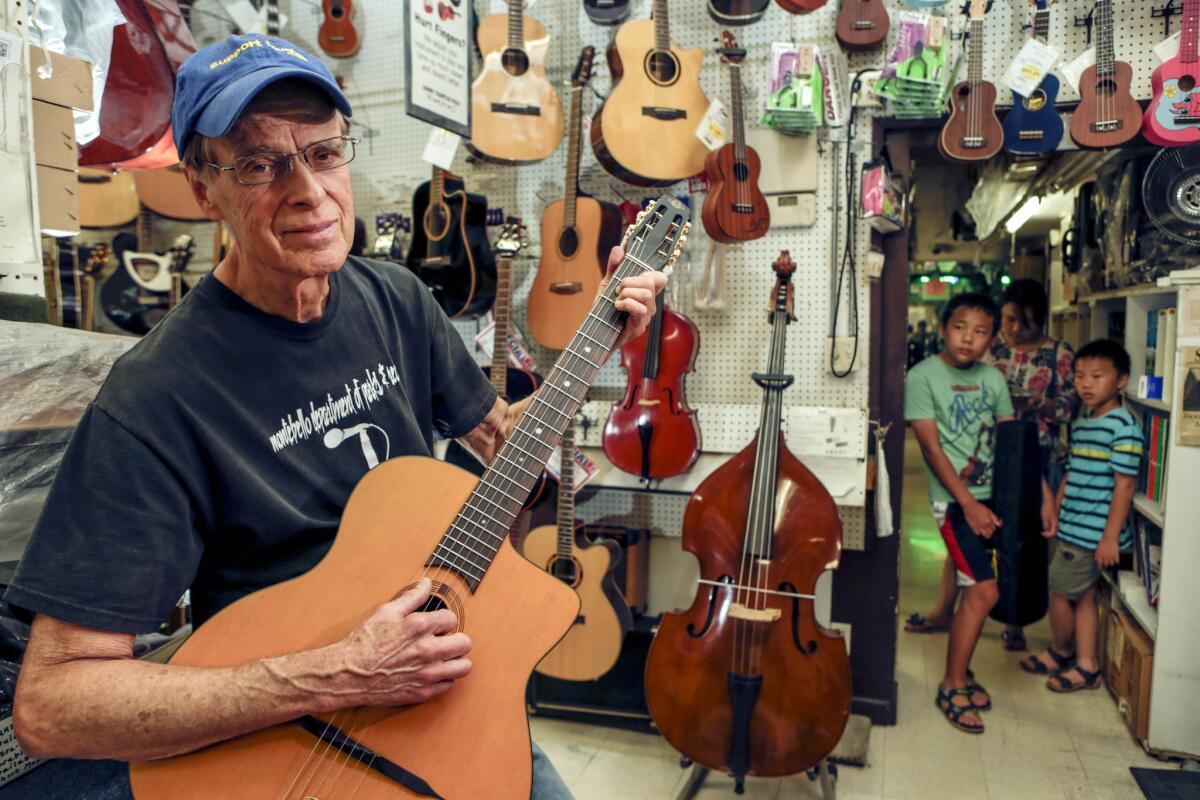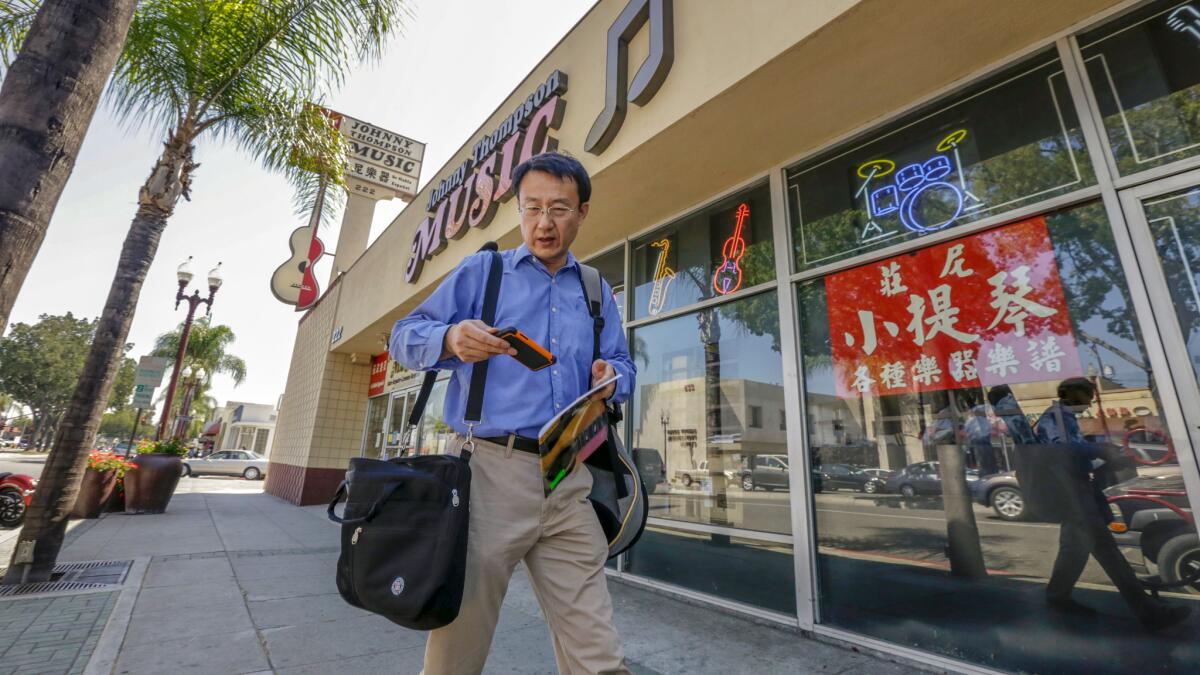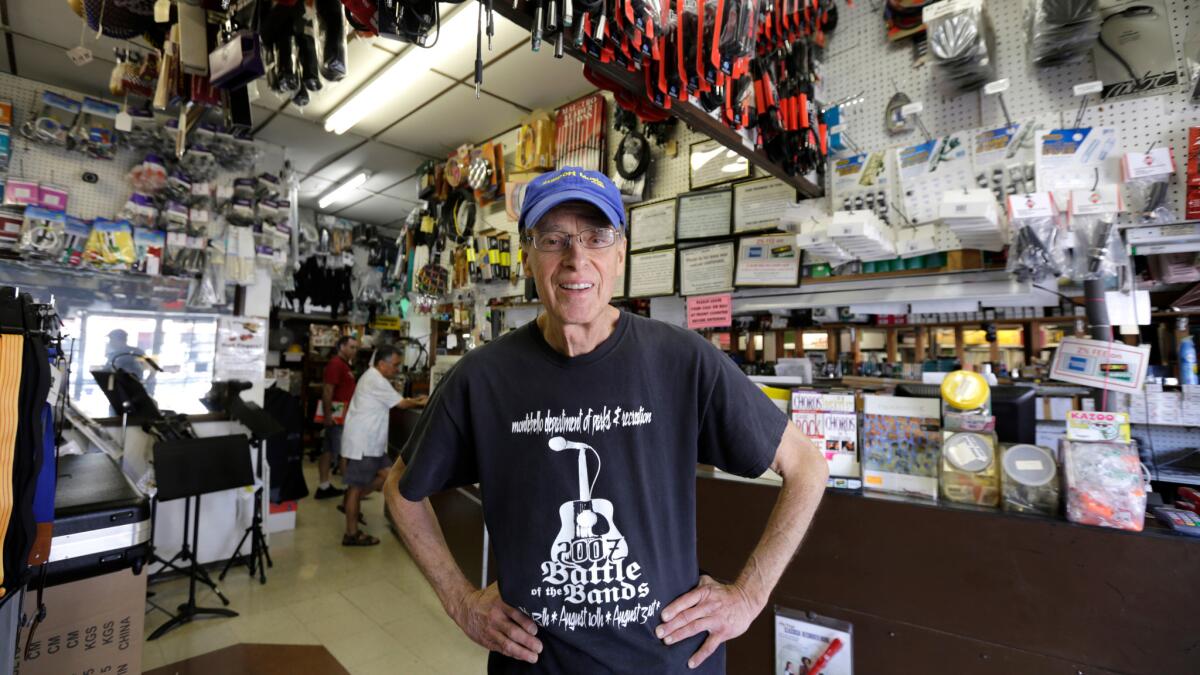When Monterey Park became more Asian, this music man changed with the times and thrived

Johnny Thompson Music endures amid a wave of Asian immigration that has changed the San Gabriel Valley and California.
Typical of independent music stores, Johnny Thompson Music in Monterey Park is a monument to functional clutter: Drumsticks, guitar strings, woodwinds, sheet music, violins, amp cords, trumpets — you name it, it hangs from every wall, stuffs every shelf and covers every inch of floor space not needed for foot traffic.
A selection of long-necked Chinese string instruments, displayed next to mariachi guitars, hints at what’s atypical about the store, now in its 54th year.
For the record:
12:49 p.m. Nov. 8, 2024An earlier version of this story said that Johnny Thompson music is located on East Garvey Avenue.
Located on E. Garvey Avenue in the Monterey Park business district, Johnny Thompson Music sits at the epicenter of an ongoing wave of Asian immigration that has changed the San Gabriel Valley and California.
Originally, a lot of residents felt that they were being invaded by foreigners.
— Johnny Thompson

“This is where it all started,” said the 72-year-old Thompson, a native of the suburban city of 60,000 residents, east of downtown Los Angeles, “right here in downtown Monterey Park. Right here in the business district.”
The story of Monterey Park’s transformation into what has been called America’s first suburban Chinatown has been well-chronicled, to the point that city officials long ago grew weary of the narrative: The brash real estate developer who arrived in the 1970s with a vision to repopulate the working-class town with Asian immigrants; the political backlash in the 1980s; and the white exodus.
Johnny Thompson, though, offers a seldom heard coda. Forty years after the changes began, he remains. The thin, sad-eyed former musical prodigy chose not to sell his business, though he had offers. He chose not to be that “last [white] American,” as an infamous bumper sticker put it, “to leave Monterey Park.”
Everyone in the room thought the guy was blowing smoke . . . He told me his plans, and I thought he was a visionary.
— Johnny Thompson

He chose to adapt.
“Very few stayed,” he said the other day, sitting on a metal chair in a lessons cubicle that doubles as a storage space for amplifiers. “All the downtown business owners either left or have since retired. So I guess I’m the last one.”
::
Change in California can come on subtly, barely noticed at first. Or it can be literally, but more often metaphorically, seismic: The Gold Rush. The transcontinental railroad. World War II and its baby boom aftermath. Immigration, first from within the States, then from the south, and now from across the Pacific.
Incremental or epic, change has been California’s constant from the start. As the late Carey McWilliams once observed, the state “has not grown or evolved so much as it has been hurtled forward, rocket-fashion, by a series of chain-reaction explosions.”
It’s the velocity that Thompson remembers most when he looks back at the transformation that stormed through his hometown: “It was a tsunami. It came all at once, and it kept coming. And to this day it is still coming.”
Today, out of every 100 residents living in Monterey Park, 70 on average are Asian and 25 are Latino; five are white. But the surge in the Asian population is not confined to Monterey Park, or even the San Gabriel Valley.
Asians now constitute the fastest-growing cohort in California. A recent study by the Public Policy Institute of California cast it as a sea change from the decades when immigrants from Latin America were driving population growth:
“Since 2006, Asia has replaced Latin America as the leading source of new immigrants. In 2013, more than twice as many immigrants arrived from Asia as from Latin America, and China replaced Mexico as the leading country of origin.”
As often happens with societal shifts in California, the events that laid the groundwork for change were not obvious at the time: Who knew that so-called ping-pong diplomacy, or Nixon’s visit to China, or a normalization of relations with China under the Carter administration, would bring wholesale change to California suburbs?
But not everybody missed it. In 1977, Frederick Hsieh, a Chinese immigrant turned developer, met with 20 Monterey Park business leaders, informing them, as one participant told the Los Angeles Times a decade later, “that Monterey Park was going to become the next Chinatown.”
“He said it would be a mecca for Chinese,” the business leader went on. “Everyone in the room thought the guy was blowing smoke.”
Johnny Thompson had a different reaction.
“I met with him,” he recalled. “He told me his plans, and I thought he was a visionary.”
From Taiwan, Hong Kong, mainland China and eventually several other Pacific Rim nations, the immigrants began to pile in. First they bought houses and property, then they began to snap up businesses. Thompson recalls “rumors to the effect that people were coming in with bags of cash, and they were paying prices nobody could refuse.”
Thompson could, and did.
“I don’t know how many, but we had offers, we had offers. I didn’t even listen to them.”
Why not?
“This is my hometown and my business. I saw no need whatsoever to sell out. I was still a young man and I had no desire to retire or move on to another location or anything like that. I decided to adjust.”
He worked with Hsieh, since deceased, to establish what eventually would become the city’s downtown business improvement district, an organization Thompson now chairs.
He changed his giant rooftop sign, adding Chinese characters to denote “Johnny’s Music,” next to where it already read “Se habla Espanol.”’
It has worked out very well. That is the good thing about America. Diversity always wins out, and it makes everybody better.”
— Johnny Thompson

He began to stock traditional Chinese instruments: qingins and banhus and zhengs.
And he hired a 14-year-old Chinese-Vietnamese immigrant to serve as interpreter, buying time before he could bring on board a corps of instructors who could speak the language.
::
Change, especially volatile change, can be met with great resistance. One memorable example from another California valley, the San Joaquin: In the 1970s, growers insisted on equipping their field hands with short-handled hoes — a back-straining implement that made functional sense only when hoeing in certain, weed-like crops.
With long-handled hoes, the agricultural industry warned, production would tumble and costs would soar. But the state, prodded by the farm labor movement, banned the short-handled hoe and … nothing. Production did not decline. Costs did not soar.
“We fought this thing and worried over it and now it turns out to be not a problem,” a Salinas Valley lettuce grower told a Times reporter at the time. “Frankly,” he added, with uncommon candor, “I feel like a goddamn jackass.”
The short-handled hoe of Monterey Park was language. Stores with only Chinese-language signs proved controversial. Longtime residents sensed a snub; the fire department worried about confusion in emergencies. Ballot box efforts were undertaken, unsuccessfully, to designate English as the city’s “official” language. A rash of signs and bumper stickers asked, infamously, “Will the last American to leave Monterey Park please bring the flag?”
Thompson was not, and is not, without empathy for the residents who recoiled at the changes: “Originally, a lot of residents felt that they were being invaded by foreigners. And those people pulled up stakes and moved, a lot of them, or they stayed and tried to argue about it.”
Thompson followed the controversies but did not engage in them. Instead, he let time do its work.
“For the Chinese people at first, language was a big problem, and they brought in their own customs. But over time, they have managed to keep their family values, their educational values from their old country, and at the same time adapt to American social structures. I think it is the best of both worlds.”
It was now midafternoon on a Monday, and the store’s entrance bell began to ring steadily as young music students arrived for their after-school lessons. Some, still dressed in school uniforms, toted cased instruments that seemed to outweigh them.
Some were third-generation residents of America’s first suburban Chinatown, as likely to be taking summer courses in Mandarin as their parents were to take supplemental English lessons at the language schools that popped up all over town in the early years.
A musical cacophony filled Johnny Thompson Music, scales being played on a piano in one cubicle, on a trumpet in another: “The universal language,” said Thompson, who long ago stopped playing music himself to concentrate on business and civic activities.
“I think it has all worked out,” he said finally, rising to free up the cubicle for a tiny violinist-to-be and her instructor. “It has worked out very well. That is the good thing about America. Diversity always wins out, and it makes everybody better.”
That, anyway, is the view of the Garvey Avenue merchant who rode out the tsunami of change. In parting, Johnny Thompson said he has no plans to retire, no plans to leave Monterey Park.
“Where would I go?”
ALSO
Thousands gather in downtown L.A. for CicLAvia bike festival
So much has changed in East L.A. since 1928 -- but not handball
‘All we do is clean and clean’: There are big plans for MacArthur Park, but residents are skeptical
UPDATES:
5:06 p.m. Wednesday: An earlier headline on this story erroneously described Johnny Thompson as the “last American” in Monterey Park.
More to Read
Sign up for Essential California
The most important California stories and recommendations in your inbox every morning.
You may occasionally receive promotional content from the Los Angeles Times.











